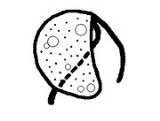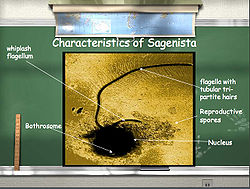
Sagenista
Encyclopedia

Heterokont
The heterokonts or stramenopiles are a major line of eukaryotes currently containing more than 100,000 known species. Most are algae, ranging from the giant multicellular kelp to the unicellular diatoms, which are a primary component of plankton...
s which contains the bicosoecids. It also contains slime nets (Labyrinthulids).
It has a special organelle
Organelle
In cell biology, an organelle is a specialized subunit within a cell that has a specific function, and is usually separately enclosed within its own lipid bilayer....
called a Bothrosome. It is usually found in a marine environments rich in algae and sea grass. It is capable of movement by use of this organelle.
They are generally decomposers.
Bothrosome
They are capable of excreting an extoplasmic net of filaments for cells to glide upon. These tiny filaments provide a network for cells to travel upon to soak up nutrients from the surrounding environment.Uses of Sagenista and Labyrinthulomycota
They are cultivated for their active production of Omega-3 fatty acidOmega-3 fatty acid
N−3 fatty acids are essential unsaturated fatty acids with a double bond starting after the third carbon atom from the end of the carbon chain....
s. These acids are used as an approved additive for animal feed.
Genera
- LabyrinthulaLabyrinthulaLabyrinthula is a genus of heterokont, comprising ten species....
: Possesses a bothrosome. It is being studied for its pathogenic nature in marine environments. It has killed an entire species of Sea grass as well as some species, such as a particular snail that relies on the grass.
- Caecitellus
- Roughly spyhrical,
- Only 2-7 meters (6.5-23') in diameter,
- Has two flagellum,
- Glide on filaments produced by bothrosome,
- The two flagella provide a wrap around the organism to form a sort of exoskeleton,
- CafeteriaCafeteria (bicosoecid)Cafeteria is a genus of marine bicosoecid described in 1988 by Tom Fenchel and D.J. Patterson. It was created after the discovery of a new species Cafeteria roenbergensis, a tiny eukaryotic organism that is eaten by protozoa and small invertebrates. The name is meant to indicate the importance of...
. Planktonic species which has only been found in salt water. The two flagellum propel the cell. Reproduce asexually through binary division. Feed on bacteria and small Eukaryotes.
Other information
Until recently Sagenista was labeled as a fungusFungus
A fungus is a member of a large group of eukaryotic organisms that includes microorganisms such as yeasts and molds , as well as the more familiar mushrooms. These organisms are classified as a kingdom, Fungi, which is separate from plants, animals, and bacteria...
. It produces asexually and sexually through the use of spores.
There is a debate about whether some species of Sagenista contains a photosynthetic pigment labeled chlorophyll C.

